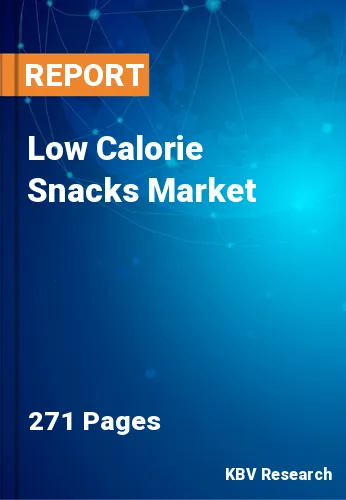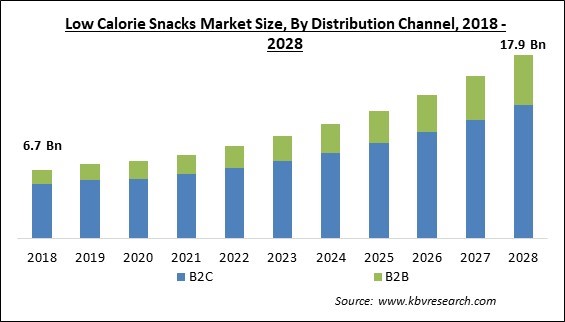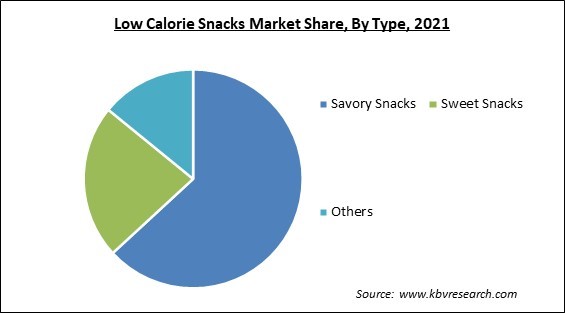
The Global Low Calorie Snacks Market size is expected to reach $17.9 billion by 2028, rising at a market growth of 12.1% CAGR during the forecast period.
As consumers continue to seek methods to reconcile nutrient-dense, healthful, and purposeful snacking with the need for emotionally rewarding and indulgent snacks, especially when snacks are of better quality, low-calorie snack foods are taking on increasingly specific responsibilities. Low-calorie snacks with natural, unprocessed components can provide several health advantages without negatively harming the body.

Increased demand and consumption of snack foods in various economies have considerably spurred the market expansion for low-calorie snacks. Increasing disposable income and shifting lifestyle and dietary preferences, the fast expansion of big retail chains, such as hypermarkets and supermarkets, an increase in the preference for ready-made and convenient food products, and an increase in people's spending power are contributing to developing the snacking sector. Furthermore, an increase in the demand for organic and conventional snack foods increases the demand for low-calorie snacks, which is accelerating the market growth for low-calorie snacks.
Over time, a greater appreciation for the significance of eating has emerged. This is attributable to the sharp increase in chronic health conditions. Consumers have embraced particular diet regimens to fight health issues and even altered their lifestyles to remain healthy. The usage of low-calorie snack foods is a noticeable trend that matches this requirement. Low-calorie snacks are popular since they do not include additives and give significantly fewer calories than are required to maintain a healthy weight.
As consumers seek a balanced diet, the industry is experiencing a rise in demand for available snacks, minimally-processed foods, and low-calorie diets. Low-calorie foods are considered a treasury of plant-based nutrients, such as protein, vitamins A, B, and C, minerals, and dietary fiber. Experts on health advocate a low-calorie diet containing at least two cups of veggies. Hence, after the slight slowdown at the start of the pandemic due to the shutdown of many food processing factories, the rising demand for healthy foods is expected to push the low-calorie snacks market significantly during and after the pandemic.
Convenient food has established itself as a dependable source of nutrition for customers who work in the business sector. This increases the market penetration of these products. As low-calorie snacks are also considered convenience meals, their industry will gain from the growth and popularity of convenience foods. Also, due to the good qualities of low-calorie organic snacking products and the rising consumer awareness of health and fitness, the market for low calorie snacks is expected to propel.
Texture variations and taste combinations are vital to expanding the market for low-calorie snack foods. The key drivers of the rising demand for low-calorie snack foods are the rising need for novel flavors and innovative twists on existing favorites. Producers use packaging strategies that highlight the food's clean labeling, non-GMO status, and certification to assist potential buyers in choosing if the product is suitable for them. Hence, the increased shelf life of many products and the high consumption of healthy and low-calorie bakery products will boost the low-calorie snacks market growth.
Individuals must consume more calories daily than they expend. Eating calorie- and nutrient-dense snacks between meals increases energy consumption without feeling satiated. As specific ingredients are required for most low-calorie and healthy foods, their prices are much greater than those of other convenience foods. This is the fundamental disadvantage of a low-calorie diet. A huge number of consumers are opting for snacks that are high in calories to maintain weight and various other reasons, are anticipated to restrict the market growth.
Based on type, the low-calorie snacks market is segmented into sweet snacks, savory snacks, and others. The sweet snacks segment acquired a significant revenue share in the low-calorie snacks market in 2021. This is owing to improved health awareness, and customers' preference for sweet delights such as cakes, pastries, ice cream, and muffins is increasing. There is a vast availability of several low-calorie, fat-free, and cholesterol-free products.
On the basis of packaging type, the low-calorie snacks market is divided into pouches, can, and jars & others. The cans segment procured a promising growth rate in the low-calorie snacks market in 2021. This is owing to the fact that can packaging manufacturers establish a new benchmark for R&D by focusing on cost-effective production sites and proximity supplies. In addition, focus on high-quality goods, changes in consumer lifestyles, and increased disposable income are the primary factors that will propel the segment's expansion during the projected period.
By distribution channel, the low-calorie snacks market is classified into B2B and B2C. The B2C segment witnessed the largest revenue share in the low-calorie snacks market in 2021. This is because these channels offer a variety of products and frequently serve as a one-stop shop for all daily needs. The urban and semi-urban populous prefers B2C due to the items' accessibility. One of the developments in the low-calorie snack industry is a rise in the number of outlets operated by major companies.
Based on the nature, the low-calorie snacks market is bifurcated into organic and conventional. The conventional segment led the low-calorie snacks market by generating the maximum revenue share in 2021. This is because the conventional category has grown in popularity due to the rise in the level of life and the awareness of the advantages of low-calorie snack items, such as their high content of antioxidants. In addition, increasing disposable income, altering taste preferences, and introducing new flavors with more nutritious components is further aiding the segment's growth in the projected period.

| Report Attribute | Details |
|---|---|
| Market size value in 2021 | USD 8.2 Billion |
| Market size forecast in 2028 | USD 17.9 Billion |
| Base Year | 2021 |
| Historical Period | 2018 to 2020 |
| Forecast Period | 2022 to 2028 |
| Revenue Growth Rate | CAGR of 12.1% from 2022 to 2028 |
| Number of Pages | 271 |
| Number of Table | 520 |
| Report coverage | Market Trends, Revenue Estimation and Forecast, Segmentation Analysis, Regional and Country Breakdown, Companies Strategic Developments, Company Profiling |
| Segments covered | Distribution Channel, Type, Packaging Type, Nature, Region |
| Country scope | US, Canada, Mexico, Germany, UK, France, Russia, Spain, Italy, China, Japan, India, South Korea, Singapore, Malaysia, Brazil, Argentina, UAE, Saudi Arabia, South Africa, Nigeria |
| Growth Drivers |
|
| Restraints |
|
Region-wise, the low-calorie snacks market is analyzed across North America, Europe, Asia Pacific, and LAMEA. The Europe region generated the highest revenue share in the low-calorie snacks market in 2021. This is because the region's retail channels are well-developed and extensive. The industry for organic snacks is the largest in the area. Due to the growth in internet penetration and the availability of online meal delivery, the market for low calorie snacks has expanded dramatically.
Free Valuable Insights: Global Low Calorie Snacks Market size to reach USD 17.9 Billion by 2028
The market research report covers the analysis of key stake holders of the market. Key companies profiled in the report include Ingredion Incorporated, The Kraft Heinz Company, The Hain Celestial Group, Inc., Conagra Brands, Inc., Nestle S.A., Archer-Daniels-Midland Company, General Mills, Inc., Danone, S.A., Mondelez International, Inc., and Cargill, Corporation.
By Distribution Channel
By Type
By Packaging Type
By Nature
By Geography
The global Low Calorie Snacks Market size is expected to reach $17.9 billion by 2028.
The increasing demand for low calorie bakery products with extended shelf life are driving the market in coming years, however, Low product demand in various regions restraints the growth of the market.
Ingredion Incorporated, The Kraft Heinz Company, The Hain Celestial Group, Inc., Conagra Brands, Inc., Nestle S.A., Archer-Daniels-Midland Company, General Mills, Inc., Danone, S.A., Mondelez International, Inc., and Cargill, Corporation.
The Savory Snacks segment is acquired maximum revenue share in the Global Low Calorie Snacks Market by Type in 2021 thereby, achieving a market value of $11 billion by 2028.
The Pouches segment is leading the Global Low Calorie Snacks Market by Packaging Type in 2021 thereby, achieving a market value of $8.8 billion by 2028.
The Europe market dominated the Global Low Calorie Snacks Market by Region in 2021, and would continue to be a dominant market till 2028; thereby, achieving a market value of $5.8 billion by 2028.
Our team of dedicated experts can provide you with attractive expansion opportunities for your business.
